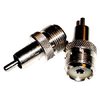Hi HA .... No not really. You seem to be giving answers to questions that I did not ask - both times - but I appreciate your interest anyway friend.
You're welcome, I took it more like a lesson on when you remove the little constraints of getting the signal from the radio to the antenna. Like impedance "bumps" each connector and connection point along the line induces - what you have left is a considerable amount of freedom to produce, provide and radiate a signal from a known impedance into another "expected" impedance and you get rid of the required impedance constraints the conduit to connect them both is. That is where the HT can excel at efficiency in radiated signals where other more dedicated systems, if not provided for, will fail miserably at.
The HT design is interesting, it's self contained, so they only needed to make a network that kept the environment from reflecting back to the final.
It also has a uniqueness that being portable for what it is, didn't need all the filtering - FCC didn't enforce the filtering issue on them at first, but later, it became necessary. It's unfortunate - although later models provided it because people used them for base stations too - which the FCC had to initiate another stage or process of having the radio makers install better filtering in later model years...
The output network of a final - the impedance is pretty low, like only several ohms, on up to maybe 25 ohms at best.
So you (the maker) only need to concern yourself with the impedance the attachment of the whip, ducky or doorknob, becomes for the antenna - and knowing it's own impedance you simply design the network for it, not "just 50 ohms like everything else" because of the connectors and cabling support had another type of impedance which added to the problem/.
So since radiation resistance is pretty low for shorter antennas like those used in HT's - you have heavy capacitance as "seen" by the final - but remember you don't have that 50-ohm impedance constraint - just do up a network for that "range of impedance" the antenna appears as to the HT. It will use a given amount and the rest will take care of itself. It's not ideal, but it does work - not an ideal "tower of power" but the longer whips and dedicated systems made the HT do pretty well for what little power they actually had.
It was the SWR thing I'm still trying to get my head around. I'll never really know if I got it right or not...
It looks as - even if the lower the impedance the HT can use, in the system, the more it relies on the radiation and open circuit resistance factor (those caps inside in the PI-network) - hence the more the open circuit the thing is, the radiation resistance even as low as it is, as seen by the final in the HT, can be overcome by the loading it uses inside to help transfer the signal to the outside and in doing so- keeps the SWR issues from becoming a big deal inside - by forcing the SWR reflection seen by the final as a higher impedance than the outgoing signal is But as it comes back into the system, the reflected signal just "dumps" into the output capacitance just past the coil - the cap(s) appear as a dead short to it.
So there used to be a BIG argument in the USENET rec.radio.* groups that took this discussion down, pared it down - nearly to the atomic level - about how output networks absorb the energy - and their mechanisms that did this process. For in light of the HT - that network issue was specific to the device, not to the system - for it was a "unit" as system in itself - not something that you had to make accommodations for, like in the cabling and connections and their impedance requirements to get the signal out to radiate and receive likewise.
So sorry for the long letter - but your situation is unique for that this equipment was made in the past for "portable" and yet even in our current system and frames of mind, we can use those lessons learned from such time, and a simple system and apply it out in the real world.
But most of all, enjoy the radio - a piece of history, and have a great Xmas to go along with it.





